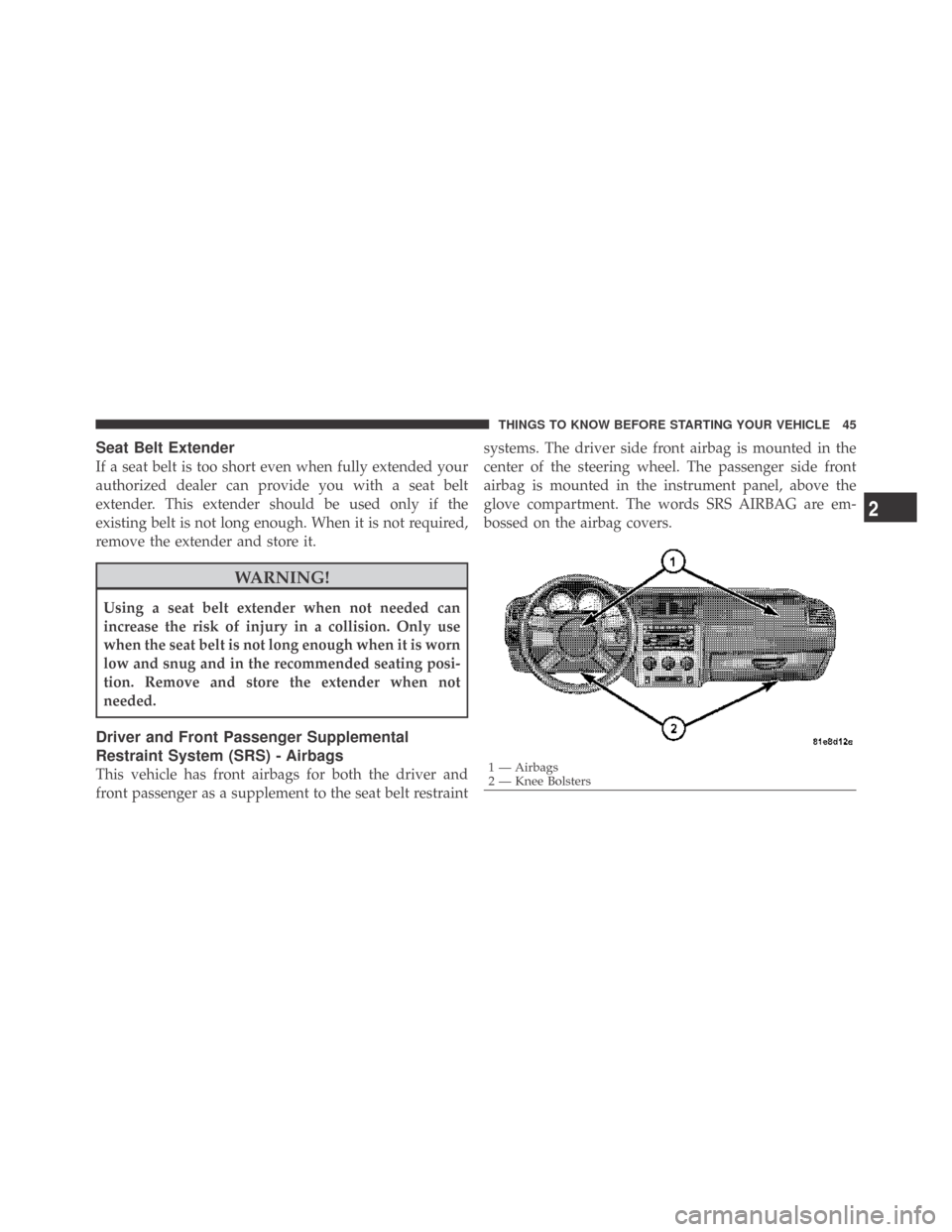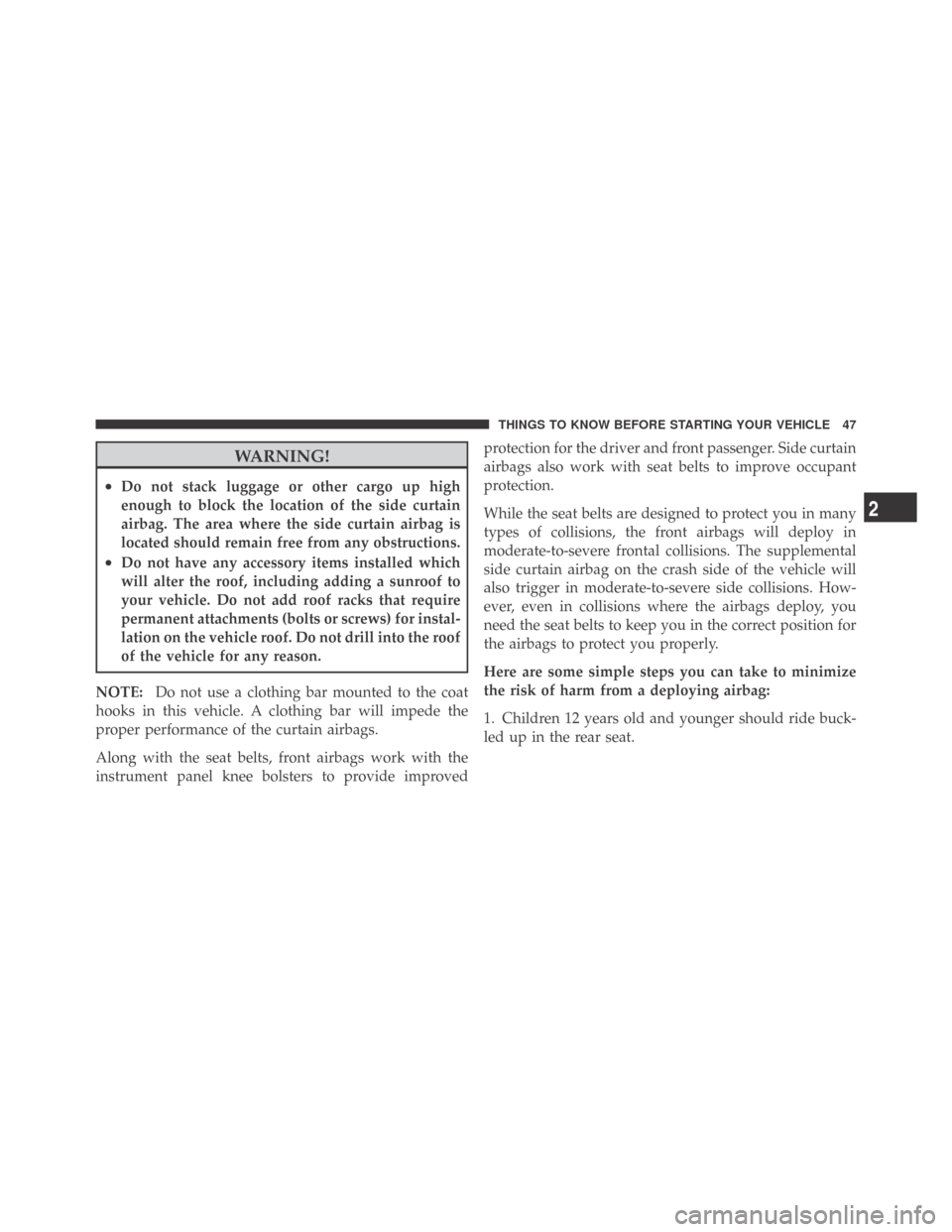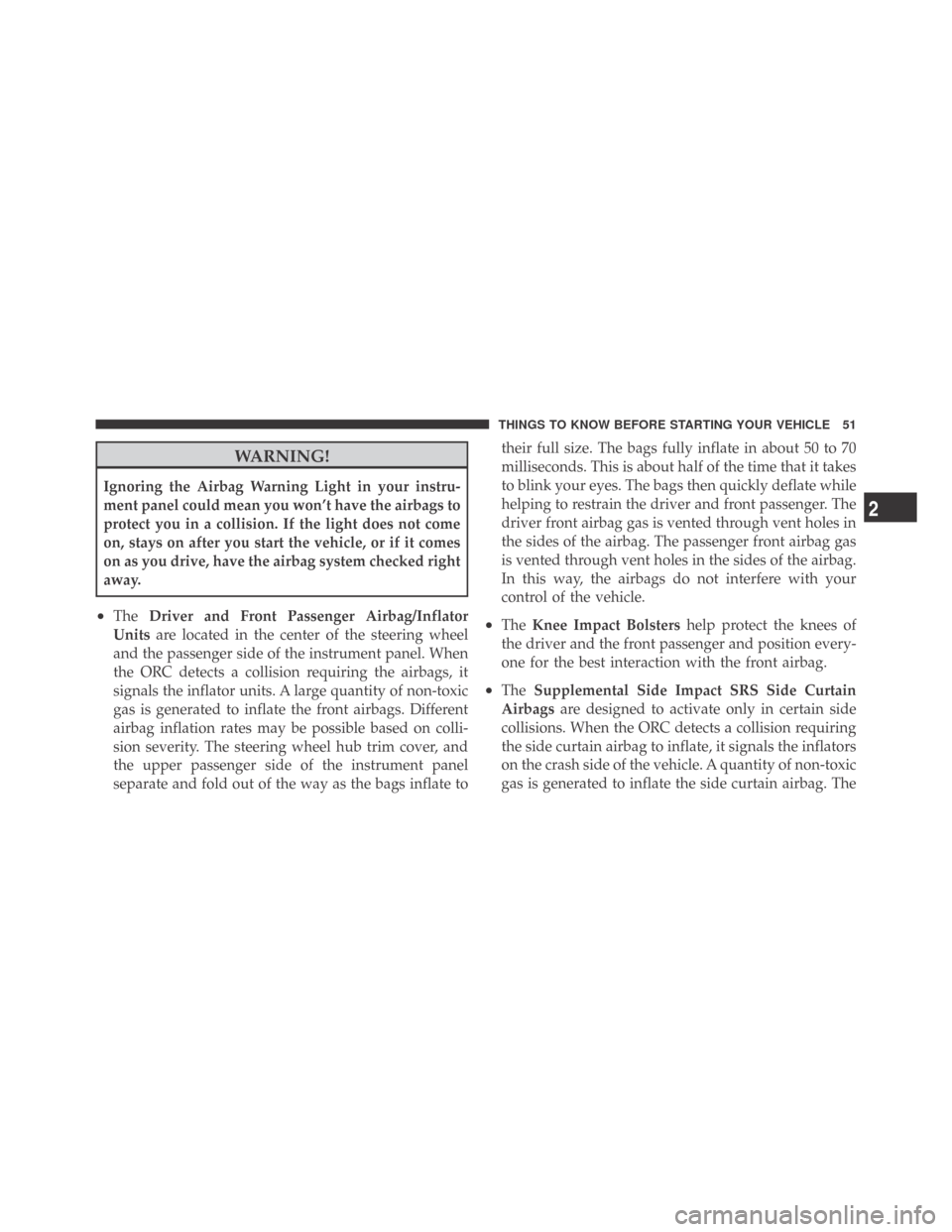Page 3 of 469
TABLE OF CONTENTSSECTIONPAGE
1INTRODUCTION............................................................3
2THINGS TO KNOW BEFORE STARTING YOUR VEHICLE..............................9
3UNDERSTANDING THE FEATURES OF YOUR VEHICLE............................. 71
4UNDERSTANDING YOUR INSTRUMENT PANEL.................................. 149
5STARTING AND OPERATING................................................239
6WHAT TO DO IN EMERGENCIES............................................. 337
7MAINTAINING YOUR VEHICLE..............................................363
8MAINTENANCE SCHEDULES.................................................417
9IF YOU NEED CONSUMER ASSISTANCE........................................ 433
10INDEX...................................................................443
1
2
3
4
5
6
7
8
9
10
Page 8 of 469
WARNINGS AND CAUTIONS
This Owner’s Manual containsWARNINGSagainst op-
erating procedures that could result in an accident or
bodily injury. It also containsCAUTIONSagainst proce-
dures that could result in damage to your vehicle. If you
do not read this entire manual, you may miss important
information. Observe all Warnings and Cautions.
VEHICLE IDENTIFICATION NUMBER
The Vehicle Identification Number (VIN) is on the left
front corner of the instrument panel and is visible from
outside of the vehicle through the windshield. This
number also appears on the Automobile Information
Disclosure Label affixed to a window on your vehicle, the
vehicle registration, and the title.NOTE:It is illegal to remove or alter the VIN.
VIN Location
6 INTRODUCTION
Page 36 of 469
TRUNK LOCK AND RELEASE
The trunk lid can be released from inside the vehicle by
pressing the Trunk Release button. The button is located
on the instrument panel to the left of the steering wheel.
NOTE:The transmission must be in PARK before the
button will operate. If equipped with a manual transmis-
sion, the vehicle speed must be under 5 mph (8 km/h)
before the button will operate.
The trunk lid can be released from
outside the vehicle by pressing the
Trunk Release button on the Re-
mote Keyless Entry (RKE) trans-
mitter twice within five seconds.With the ignition switch in the ON position, the Trunk
Open symbol will display in the instrument cluster
indicating that the trunk is open. The odometer display
will reappear once the trunk is closed.
With the ignition switch in the LOCK position or the key
removed from the ignition switch, the Trunk Open sym-
bol will display until the trunk is closed.
Trunk Release
Button
34 THINGS TO KNOW BEFORE STARTING YOUR VEHICLE
Page 47 of 469

Seat Belt Extender
If a seat belt is too short even when fully extended your
authorized dealer can provide you with a seat belt
extender. This extender should be used only if the
existing belt is not long enough. When it is not required,
remove the extender and store it.
WARNING!
Using a seat belt extender when not needed can
increase the risk of injury in a collision. Only use
when the seat belt is not long enough when it is worn
low and snug and in the recommended seating posi-
tion. Remove and store the extender when not
needed.
Driver and Front Passenger Supplemental
Restraint System (SRS) - Airbags
This vehicle has front airbags for both the driver and
front passenger as a supplement to the seat belt restraintsystems. The driver side front airbag is mounted in the
center of the steering wheel. The passenger side front
airbag is mounted in the instrument panel, above the
glove compartment. The words SRS AIRBAG are em-
bossed on the airbag covers.1 — Airbags
2 — Knee Bolsters
2
THINGS TO KNOW BEFORE STARTING YOUR VEHICLE 45
Page 49 of 469

WARNING!
•Do not stack luggage or other cargo up high
enough to block the location of the side curtain
airbag. The area where the side curtain airbag is
located should remain free from any obstructions.
•Do not have any accessory items installed which
will alter the roof, including adding a sunroof to
your vehicle. Do not add roof racks that require
permanent attachments (bolts or screws) for instal-
lation on the vehicle roof. Do not drill into the roof
of the vehicle for any reason.
NOTE:Do not use a clothing bar mounted to the coat
hooks in this vehicle. A clothing bar will impede the
proper performance of the curtain airbags.
Along with the seat belts, front airbags work with the
instrument panel knee bolsters to provide improvedprotection for the driver and front passenger. Side curtain
airbags also work with seat belts to improve occupant
protection.
While the seat belts are designed to protect you in many
types of collisions, the front airbags will deploy in
moderate-to-severe frontal collisions. The supplemental
side curtain airbag on the crash side of the vehicle will
also trigger in moderate-to-severe side collisions. How-
ever, even in collisions where the airbags deploy, you
need the seat belts to keep you in the correct position for
the airbags to protect you properly.
Here are some simple steps you can take to minimize
the risk of harm from a deploying airbag:
1. Children 12 years old and younger should ride buck-
led up in the rear seat.
2
THINGS TO KNOW BEFORE STARTING YOUR VEHICLE 47
Page 51 of 469

WARNING!
•Relying on the airbags alone could lead to more
severe injuries in a collision. The airbags work
with your seat belt to restrain you properly. In
some collisions, the airbags won’t deploy at all.
Always wear your seat belts even though you have
airbags.
•Being too close to the steering wheel or instrument
panel during airbag deployment could cause seri-
ous injury. Airbags need room to inflate. Sit back,
comfortably extending your arms to reach the
steering wheel or instrument panel.
•This vehicle has supplemental side curtain air-
bags, and they need room to inflate. Do not lean
against the door or window. Sit upright in the
center of the seat.
Airbag System Components
The airbag system consists of the following:
•Occupant Restraint Controller (ORC)
•Side Remote Acceleration Sensors
•Side Door Pressure Sensors
•Airbag Warning Light
•Driver Airbag
•Front Passenger Airbag
•Supplemental Side Curtain Airbags above Side Win-
dows
•Steering Wheel and Column
•Instrument Panel
•Interconnecting Wiring
•Seat Belt Reminder Light
2
THINGS TO KNOW BEFORE STARTING YOUR VEHICLE 49
Page 52 of 469

•Knee Impact Bolsters
•Front Acceleration Sensors
•Driver and Front Passenger Seat Belt Pretensioners
How the Airbag System Works
•
TheOccupant Restraint Controller (ORC)determines
if a frontal collision is severe enough to require the
airbags to inflate. The front airbag inflators are de-
signed to provide different rates of airbag inflation
from direction provided by the ORC. The ORC will not
detect rollover.
•The ORC also determines if a side impact is severe
enough to deploy the supplemental side curtain airbag
as required for each type of impact.
•The ORC also monitors the readiness of the electronic
parts of the system whenever the ignition switch is in
the START or ON position. These include all of theitems listed above except the knee bolster, the instru-
ment panel, and the steering wheel and column. If the
key is in the LOCK position, in the ACC position, or
not in the ignition, the airbags are not on and they will
not inflate.
•The ORC also turns on the Airbag Warning
Light in the instrument panel for six to eight
seconds as a self-check when the ignition is
first turned on. After the self-check, the
Airbag Warning Light will turn off. If the ORC detects
a malfunction in any part of the system, it turns on the
Airbag Warning Light either momentarily or continu-
ously. A single chime will sound if the light comes on
again after initial start-up.
50 THINGS TO KNOW BEFORE STARTING YOUR VEHICLE
Page 53 of 469

WARNING!
Ignoring the Airbag Warning Light in your instru-
ment panel could mean you won’t have the airbags to
protect you in a collision. If the light does not come
on, stays on after you start the vehicle, or if it comes
on as you drive, have the airbag system checked right
away.
•TheDriver and Front Passenger Airbag/Inflator
Unitsare located in the center of the steering wheel
and the passenger side of the instrument panel. When
the ORC detects a collision requiring the airbags, it
signals the inflator units. A large quantity of non-toxic
gas is generated to inflate the front airbags. Different
airbag inflation rates may be possible based on colli-
sion severity. The steering wheel hub trim cover, and
the upper passenger side of the instrument panel
separate and fold out of the way as the bags inflate totheir full size. The bags fully inflate in about 50 to 70
milliseconds. This is about half of the time that it takes
to blink your eyes. The bags then quickly deflate while
helping to restrain the driver and front passenger. The
driver front airbag gas is vented through vent holes in
the sides of the airbag. The passenger front airbag gas
is vented through vent holes in the sides of the airbag.
In this way, the airbags do not interfere with your
control of the vehicle.•TheKnee Impact Bolstershelp protect the knees of
the driver and the front passenger and position every-
one for the best interaction with the front airbag.
•TheSupplemental Side Impact SRS Side Curtain
Airbagsare designed to activate only in certain side
collisions. When the ORC detects a collision requiring
the side curtain airbag to inflate, it signals the inflators
on the crash side of the vehicle. A quantity of non-toxic
gas is generated to inflate the side curtain airbag. The
2
THINGS TO KNOW BEFORE STARTING YOUR VEHICLE 51